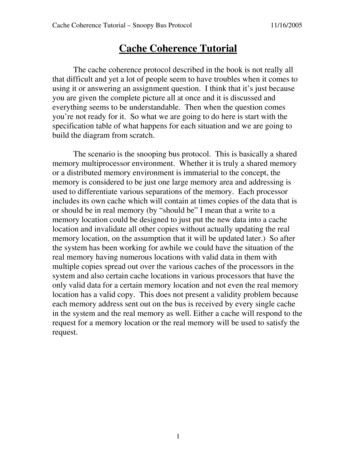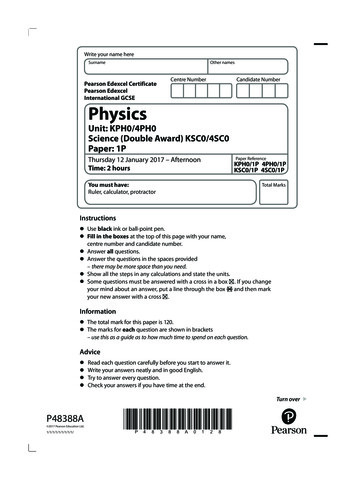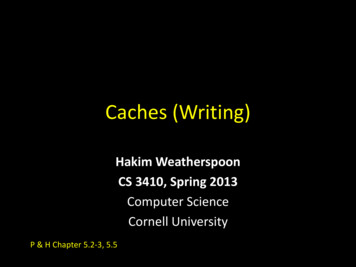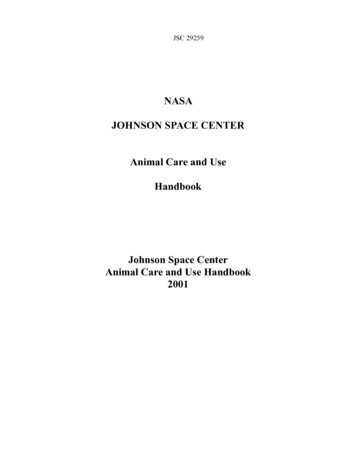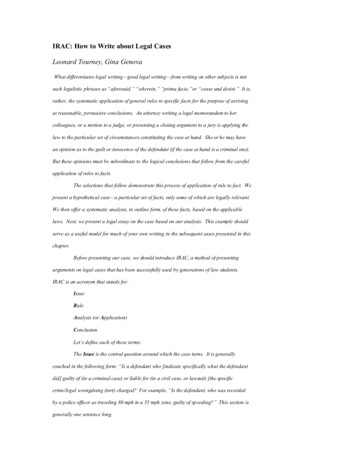
Transcription
IRAC: How to Write about Legal CasesLeonard Tourney, Gina GenovaWhat differentiates legal writing—good legal writing—from writing on other subjects is notsuch legalistic phrases as “aforesaid,” “wherein,” “prima facie,”or “cease and desist.” It is,rather, the systematic application of general rules to specific facts for the purpose of arrivingat reasonable, persuasive conclusions. An attorney writing a legal memorandum to hercolleagues, or a motion to a judge, or presenting a closing argument to a jury is applying thelaw to the particular set of circumstances constituting the case at hand. She or he may havean opinion as to the guilt or innocence of the defendant (if the case at hand is a criminal one).But these opinions must be subordinate to the logical conclusions that follow from the carefulapplication of rules to facts.The selections that follow demonstrate this process of application of rule to fact. Wepresent a hypothetical case—a particular set of facts, only some of which are legally relevant.We then offer a systematic analysis, in outline form, of these facts, based on the applicablelaws. Next, we present a legal essay on the case based on our analysis. This example shouldserve as a useful model for much of your own writing in the subsequent cases presented in thischapter.Before presenting our case, we should introduce IRAC, a method of presentingarguments on legal cases that has been successfully used by generations of law students.IRAC is an acronym that stands for:IssueRuleAnalysis (or Application)ConclusionLet’s define each of these terms:The Issue is the central question around which the case turns. It is generallycouched in the following form: “Is a defendant who [indicate specifically what the defendantdid] guilty of (in a criminal case) or liable for (in a civil case, or lawsuit) [the specificcrime/legal wrongdoing (tort) charged? For example, “Is the defendant, who was recordedby a police officer as traveling 80 mph in a 55 mph zone, guilty of speeding?” This section isgenerally one sentence long.
The Rule is the primary law (or set of laws) that apply in this case. It is quotedverbatim (and placed within quotation marks) because the letter of the law is crucial. This rulemay be a statutory law (such as a section of the criminal code, like arson) or it may be anaccepted legal principle based on precedent. This section is frequently one sentence long.Note: secondary rules—those that define or clarify certain elements or terms of the primaryrule (such as “privileged” or “intent”)—may also apply to the case. These secondary rulesare introduced in the appropriate places in the next section, the Analysis.The Analysis, the longest section of the essay, is a systematic application ofcomponents—or elements of the primary and secondary rules—to those facts of the case thatare legally relevant. For example, robbery is defined in the California Penal Code (section211) as “the felonious taking of personal property in the possession of another, from hisperson or immediate presence, and against his will, and accomplished by means of force orfear.” The separately underlined phrases are individual elements of robbery, and eachelement must be satisfied for the defendant to be found guilty of robbery. In the case ofphrases joined by “or” (as in “force or fear”), only one of the two elements need be satisfied.In the analysis, it is frequently necessary to bring in additional legal principles thatprovide definitions or clarifications of key terms in the primary rule. These secondary rulesshould also be quoted verbatim. For example, the self-defense privilege is a secondary rulethat clarifies the conditions under which an attack against another may be legally justified, or“privileged.” By “facts of the case that are legally relevant” (in the paragraph above) wemean those facts that can be associated with one or more elements of the rule. For example,the fact that the defendant used a gun to inspire fear would be legally relevant. The fact thatthe defendant was in a bad mood because he had just been fired from his job is legallyirrelevant. In general, it is a good idea to use climactic order in developing your analysis.That is, first dispose of those elements about which there is likely to be little dispute or aboutwhich there is little question as to whether they have been satisfied. Then, move on to theelements that require more extended discussion.It is a good idea to conclude each section of the analysis by indicating in somemanner that a particular element of the rule has or has not been satisfied. However, defer theoverall conclusion (the guilt or innocence or liability or non-liability of the defendant) for the
very end of the essay. Do not conclude guilt or liability prematurely, before you haveanalyzed all the applicable facts!Also, do not merely summarize facts in this section, as if they speak for themselves.Analyze them by applying rule to fact.The Conclusion is the answer to the question that is posed in the Issue statement. Itis generally no more than a few sentences (and sometimes just one sentence) long.To see how this process works, read the following selections. First we present ahypothetical case, “Incident at the Airport,” written by Leonard Tourney, who teaches legalwriting at the University of California at Santa Barbara. Next we present an analysis of thiscase in outline format, with a systematic application of each element of the rule (in this case,the rule for battery) to the relevant facts of the case. The analysis was written by GinaGenova, who also teaches legal writing at U.C., Santa Barbara, and who practices law in thatcity. Next, we present a model legal essay based on Genova’s analysis, written by LeonardTourney. Tourney’s essay is followed by his “Short Guide to Writing Effective IssueStatements.” Finally, we present three problematic model essays (written by Tourney) basedon the “Incident at the Airport” scenario. You are invited to discover and discuss theproblems.Incident at the AirportLeonard TourneyLisa St. John arrived at Los Angeles International Airport late in the afternoon after agrueling flight from London via New York and Chicago. She was exhausted andirritable, ready to chuck her job as a computer consultant for internationalcorporations. Her mood did not improve when she found that Frank Mason, herfiancé, was not waiting to pick her us as he had promised. She had long suspectedFrank of being a closet flake just waiting to reveal himself to her after he and Lisawere married and only an expensive divorce would undo the damage. The upside ofhis failure to show was that it gave Lisa cause to break things off. While she waited,she steamed and rehearsed just how she would ell him to marry someone else.
The plane had arrived at 4. Frank didn’t appear until nearly 7. Lisa hadavoided eating so that her blood sugar level would drop. She wanted to feel awful,look awful. Frank deserved what he got: a whining, inconsolable wreck. Then shesaw him, and her cup of wrath overflowed. Frank was smiling, carrying a dozenroses and a box that looked very much like Lisa’s favorite chocolates. He threw hisarms open wide to greet her and in so doing hit Eben Sommers, a 90 year old manwaiting to get a plane to Detroit. The blow broke Mr. Sommers’ glasses and hisnose.“You moron, why don’t you watch what you’re doing?” Lisa cried, asFrank struggled with the roses, candy, and Mr. Sommers, whom he was trying tohelp up off the floor. The old man had reminded her of her grandfather who haddied a month earlier. Enraged, Lisa kicked at Frank but missed, hitting Mr.Sommers in the leg, breaking his tibia. Mr. Sommers cried out in agony. His criesbrought Albert Fenstermocker, a German tourist, to his aid. Fenstermocker, thinkingLisa and Frank were assaulting the old man, began to beat Frank over the head withhis cane. Seeing her fiancé assaulted by a perfect stranger, Lisa’s feelings changed.She threw herself at Fenstermocker, knocking him to the ground.Write an analysis of the case above, focusing your attention of Lisa St. John’sliability for battery to Eben Sommers. Use the following rules:1. Battery. Battery is a harmful or offensive touching of another that isintentional, unconsented, and unprivileged. [primary rule]2. Transfer of Intent. In tort law [the law covering the wrongs committed byindividuals against one another], if A, intending to strike B, misses B andhits C instead, the intent to strike B is transferred and supplies the necessaryintent for the tort against C. [secondary rule]
3. Self-Defense Privilege. The right to protect oneself or another fromunlawful attack, the law of self-defense justifies an act done in reasonablebelief of immediate danger, with use of reasonable force in the absence ofmore peaceful alternatives. [secondary rule]Analysis of “Incident at the Airport”Gina GenovaIssue: Does defendant who inadvertently kicked plaintiff while intending to kick a third party whohad accidentally struck the plaintiff commit a battery?A.Did Lisa batter Mr. Sommers?1. Battery is a harmful OR offensive touching of another that is intentional, unconsentedand unprivileged.a.Harmful or offensive - Lisa kicked Mr. Sommers so hard it broke his tibia and causedhim to fall to the ground, his cries of pain so loud they brought Albert Fenstermockerto the scene. Thus, the blow was harmful to another, Mr. S.Because this element can be either harmful OR offensive and we haveproven harm, no discussion of offense needs to be made. However, hisage makes this act offensive to our cultural sensibilities as well as toMr. S personally.b.Touching – Lisa’s foot touched Mr. S’ tibia, satisfying this element.c.Intentional – After a grueling flight that left her exhausted and irritable, Lisaintentionally missed a meal and “steamed” herself into an “inconsolable hag”because Frank was late. She let herself get more angered by Frank’s flowers andchocolate, and his mishap with Mr. S who reminded her of her recently deceased
grandfather. Lisa could have stopped her mounting ire at any of these points or evenat her verbal abuse but she went further. Showing a clear intent to welcome heraggravated metal state, unwilling or unable to restrain her rage, she used it to aim akick at the object of her wrath, Frank. Unfortunately for Mr. S’ tibia, her aim wasoff and her foot found it instead. By all factual accounts, Lisa did not intend to hitMr. S. This element has not been met.Is there a rule that allows for this element to be circumvented? Yes.Transfer of Intent. In tort law, if A, intending to strike B, misses B and strikesC instead, the intent to strike B is transferred and supplies the requisite intent forthe tort against C.1. For this rule to apply, we must decide whether Lisa intended to harmanother when she inadvertently struck Mr. S.2. As analyzed aboveargued in Issue 1, Lisa intended to hit Frank whenshe missed and struck Mr. S instead. She purposely worked herselfinto a fit and was so “enraged” by Frank that she aimed to kick him. Atany time before the kick she could have stopped herself. Frank didarrive with flowers and candy, and a reasonable person might assumehe got the pick up time wrong. He also held is arms out to hug her andaccidentally hit Mr. S in the nose. She acknowledges this accident withher statement “You moron, why don’t you watch what you’re doing,”implying clumsiness not malice. Instead, she chose to disregard thesefacts, manifesting clear intent to harm Frank.3. Because Lisa intended to harm Frank, that intent is transferred to Mr. S,the actual but unintended victim.d.Unconsented – There is no evidence that Mr. S, a total stranger to Lisa and only inthe airport to board a flight, asked or allowed Lisa to strike him.
e.Unprivileged – There is no evidence that a relational privilege exits between the twostrangers: Mr. S, an innocent bystander embarking on a plane, and Lisa arriving onone. Mr. S had nothing to do with the argument between Lisa and Frank nor had heany apparent relationship or contact with either of them prior to this incident tocreate a privilege. There is, however, the possible applicability of the self-defenseprivilege.Self-Defense Privilege is the right to protect oneself or another fromunlawful attack and justifies an act done in reasonable belief ofimmediate danger, with the use of reasonable force in the absence ofmore peaceful alternatives.1. Protect oneself or another- Lisa was not under attack but she couldargue she was protecting another, Mr. S, from Frank.2. Unlawful attack – Since battery is a crime, if Frank battered Mr. S, hisactions would consituteconstitute an unlawful attack. Thus, we need towork through a quick battery IRAC: Frank hit Mr. S so hard it brokeMr. S’ nose and glasses offensive and harmful; the two werestrangers with no apparent consent and no relationship to form aprivilege unconsented; Frank; however, threw his arms wide open togreet Lisa, not to hit Mr. S. The element of intent is missing andnothing in the facts invokes the transfer of intent rule to create liabilityfor battery. We may argue then that this blow was pure accident anddid not rise to the level of “unlawful” or an “attack.”3. Belief of immediate danger – Lisa’s cry “you moron,” etc. indicates thatshe knew Frank’s actions were not intentional and she knew that shewas not in any danger. It is also unreasonable for her to fear attackfrom her fiancé since there is no indication that Frank had been abusiveto her in the past. Frank also had flowers and candy in his hands,making it difficult for him to attack anything. Finally, Frank, fully
loaded with his gifts, “struggled” to help Mr. S up – clearlycontradictory to the behavior of an aggressor. Based on all the above,Lisa could not have held any reasonable belief of immediate dangerfrom Frank.4. Reasonable force – Even if Lisa argues her belief of immediate danger,was the force she used commensurate with the threat posed? Frank’sblow did break Mr. S’ glasses and his nose. She responded with a kickso forceful that it broke Mr. S’ tibia, a traditionally strong bone. Butthe elderly are known to break bones more easily than the rest of thepopulation so, perhaps, her kick was less forceful than Frank’sbackhand. Also, since she was kicking at Frank and missed, perhapssome of the action’s momentum and force was lost. One more thing –she is a female and although we don’t know her stature, maybe Frank isa much larger person and thus a bigger threat to her & a feeble 90 yearold, warranting greater force. However, it is more likely that her forcewas unreasonable given any slight threat she felt from Frank’saccidental blow to Mr. S.5. Absence of alternatives – Lisa could easily have stopped at her verbalabuse of Frank. Or she could have merely grabbed his arms or pushedhim back down. These alternatives were far more peaceful and readilyavailable to her at the time since Frank was busy picking Mr. S up offthe ground with his hands full of gifts for her.6. Thus, Lisa cannot invoke the privilege of self-defense to avoid liability.B. Conclusion: Lisa committed an unprivileged battery upon Mr. S. Mr. S suffered damages as aresult: bodily harm of a broken leg and emotional distress. Mr. S is entitled to compensation forthese damages, which are a direct result of the battery. Lisa is therefore civilly liable to Mr. S forthe above damages in an amount to be proven at trial.
Model Student Response and Commentary: “Incident at the Airport”Leonard TourneyEssayDiscussion of EssayDoes defendant who inadvertentlyThe issue statement, in onekicked plaintiff while intended tosentence, meets the guidelineskick a third party who hadin the “Short Guide to Writingaccidentally struck the plaintiffIssue Statements” below.commit a battery?According to the law,“battery is the harmful or offensiveThe primary rule is quotedverbatim.touching of another that isintentional, unconsented, andunprivileged.”At LAX, Lisa St. John,Only the undisputed relevantdefendant, kicked Eben Sommers,facts relating to primary ruleplaintiff, breaking his tibia. Thisare summarized at the outsetconstitutes harmful and, surely,of the analysis: those dealingoffensive touching to whichwith “harmful” or “offensiveSommers, a total stranger, did nottouching” that isconsent. Sommers was aiming at a“unconsented.”third party, her fiancé, FrankHaving disposed of the “easyMason, who had accidentallycalls,” the writer takes up thestruck Sommers moments before,matter of intent, an elementbreaking his nose and glasses.about which there is some
Nevertheless, according to the rulequestion since Lisa did notof transfer of intent, “in tort law, ifintend to hit Mr. S. TheA, intending the strike B, misses Bsecondary rule of transfer ofand hits C instead, the intent tointent is quoted and thenstrike B is transferred and suppliesapplied to the factsthe necessary intent for the tortagainst C.” Therefore, Ms. St.Having applied the secondaryJohn’s intent to kick Mason isrule of transfer of intent, thetransferred to the actual victim,writer can now conclude thatSommers.the element of intent in theprimary rule has beensatisfied.But can Ms. St. John invokeAll that remains to discuss ofthe self-defense privilege to shieldthe primary rule is whetherher from liability? “The right tothe element of “unprivileged”protect oneself from another fromhas been met. To deal withunlawful attack, the law of self-this question, the writer bringsdefense justifies an act done inin the rule for the onlyreasonable belief of immediateapplicable privilege in thisdanger, with use of reasonablecase, the self-defenseforce in the absence of moreprivilege.peaceful alternatives.”Ms. St. John might argueThe writer begins theshe kicked Mason to protectdiscussion of privilege bySommers from further harm. Buroffering a counter-argumentsince her statement to Masonthat might be offered by theasking him to “watch what he wasplaintiff: she did act in selfdoing” suggests she knew thatdefense to protect plaintiffMason’s striking of Sommers wasfrom harm. The writer thenaccidental and therefore not likelydraws upon the facts to rebut
to be repeated since he wasthis defense.immediately aware of what he haddone, she cannot be said to haveacted to protect Sommers fromfurther immediate danger as thelaw requires. Nor was the force sheHaving disposed of theexerted reasonable. If she hadquestion of whether Lisa actedreally believed that Mason intendedto prevent Mr. Sommers fromanother blow against Sommers, sheharm (and thus acted tocould have seized Mason’s arms or“protect another”), the writerflung herself at him, as she didnext turns to another elementlaterwhen she threw herself at aof the self-defense privilege:German tourist assaulting Mason.whether the force Lisa usedThe kick was excessive force,was “reasonable.” Facts arereckless, given the proximity ofcited to support the argumentbystanders, and more likelythat the force was notmotivayed by anger against Masonreasonable, but ratherfor his tardiness than a desire toexcessive.protect Sommers.Given the evidence, itHaving addressed all of theseems likely that Lisa St. John willelements of the primary andbe liable to Sommers for battery.secondary rules, the writercan now conclude that thedefendant will likely be heldliable for battery. Theconclusion as to Lisa’sliability for battery has beendelayed until the end, until allanalysis has been completed.
A Short Guide to Writing Effective Issue StatementsLeonard TourneyAn issue statement is a single sentence defining exactly and correctly the legal question to beaddressed. It must define the point on which the case turns. Here are some basic rules forformulating such a sentence:1.Do not use personal names in issue statements; instead, refer to parties in the case bylegal (defendant, plaintiff) or by relevant occupational categories (employer,employee, contractor, minor, etc.). An issue statement, while originating in aspecific factual situation, is a hypothetical extrapolation. The names of theindividuals involved are immaterial.2.The issue statement, must name the specific cause of legal action (i.e., the groundsof the suit or prosecution). Vague references to defendant’s wrongdoing, liability, orcriminal conduct aren’t enough.3.The issue statement should provide specific details of the case, especially thoserelevant to the key elements of the rule. (“Did the defendant commit robbery” isinsufficient.)4.The issue statement should be grammatically correct. This means that the sentencemust be grammatically complete, verbs should agree with their subjects, and relativeclauses must be correctly linked to the words they modify. An issue statement canbe couched as a question (e.g., one beginning with “Is . . .” or “Does”) or it may becouched as a “Whether” statement (“Whether defendant, who [specific actions]commits (or is guilty of/liable for) [specific offense charged].5.An effective issue statement is concise: it doesn’t use unnecessary words to achievemaximum communication. Good sentences are fat free.6.Spell and punctuate your issue statement correctly. Avoid unnecessary commas.7.Use legal terminology correctly. (See legal glossary at end of chapter.)8.Revise your issue statement carefully. A good issue statement reflects the quality ofyour thinking about the case and increases the likelihood that the discussion thatfollows will have the same qualities.
Problematic Student Responses: “Incident at the Airport”Here are three additional student responses to the “Incident at the Airport” case. All areproblematic. Explain why.Response BHere the issue in this case is whether Lisa St. John is liable for battery against EbenSommers, a 90 year old man, injured at LAX when Lisa returned from a business trip. Batteryis the harmful or offensive touching of another than is intentional, unconsented, andunprivileged. Lisa St. John is definitely liable for battery. While she meant to kick her fiancé,she kicked Mr. Sommers instead, causing him harm and offense. Furthermore, he didn’tconsent to being kicked. The big problem here is transfer of intent. According to that rule, ifA, intending the strike B, misses B and hits C instead, the intent to strike B is transferred andsupplies the necessary intent for the tort against C. This means that her intent to strike Frankis transferred to Mr. Sommers. Thus, she committed a battery against Eben Sommers.Response CLisa St. John arrived at LAX late, in the afternoon. She was mad at her fiancé forbeing late, so when he greeted her she kicked at him, missing and hitting Eben Sommers, whowas this old guy. She broke his tibia in doing so, which was a harmful or offensive touching.It was also unconsented and unprivileged. But was it intended? According to the transfer ofintent rule, it was.The facts speak for themselves. Lisa is guilty of battery.Response DSometimes we aim at one thing and do another, hurting another person in theprocess. That’s basically what happened in this case, the issue of which is if Lisa St. Johncommitted a crime or tort against Eben Sommers.Lisa St. John committed a battery. She kicked Eben Sommers even though she didnot mean to do it, because the transfer of intent rule applies. Thus, she meets all the elementsof the following two rules . . .
Transfer of Intent. In tort law, if A, intending to strike B, misses B and strikes C instead, the intent to strike B is transferred and supplies the requisite intent for the tort against C. 1. For this rule to apply, we must decide whether Lisa intended to harm another when she inadvertently struck Mr. S. 2.

